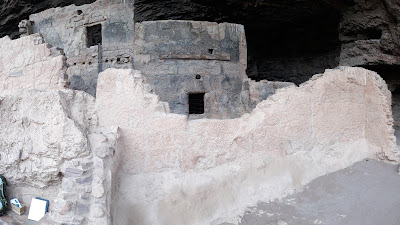 |
| The real Oscar Meyer Weinermobile was in attendance and we heard on the news that drivers were wanted. We already have a 40 foot long mobile vehicle to drive around so we did not apply. |
 |
| The skyline was actually much darker than it appears in this picture. And we saw several people launching drones in this big crowd to get a bird's eye view. |
Apache Trail Scenic Drive towards Tortilla Flats, Arizona - Wednesday, 30 January 2019
Canyon Lake
 |
| Additional wildlife also use the enlarged river for feeding and mating grounds. |
Tortilla Flats, population 6. That's not a joke. People do actually live here.
 |
| Heads on the walls and trinkets on the shelves. |
 |
| The outdoor patio for ice cream and drinks. |
 |
| Someone needs to explain how an outhouse can be "Out of Order". There are no moving parts. Maybe it's the precarious "position" at the edge of hill. |
 |
| Perching on the downward slope. The wind was also whipping through the canyons and was very chilly. |
he  |
| Both of us thought Kristen and Dave would love to take their motorcycles here and then we came across this exclamation. Apparently, we were not the only ones to have those thoughts. |
 |
| One of several one lane bridges. Not that the road is much more than a one lane road. Passing other vehicles is a snug fit even though we didn't have to negotiate with another truck. |
 |
| The loss of water from the drought is apparent along the shoreline. All the light colored stones would normally be below the water line. |
 |
| The Roosevelt Lake Bridge was completed in October 1990. The bridge was named one of the top 12 bridges in the nation in November 1995 |
 |
| This conglomerate rock has hardened like concrete and makes the hillsides very stable. |
 |
| A Park Ranger was available for discussions and to answer questions. |
 |
| These doorways are much smaller than the openings at the cliff dwellings we saw at Bandelier National Park last year near Los Alamos. |
























No comments:
Post a Comment